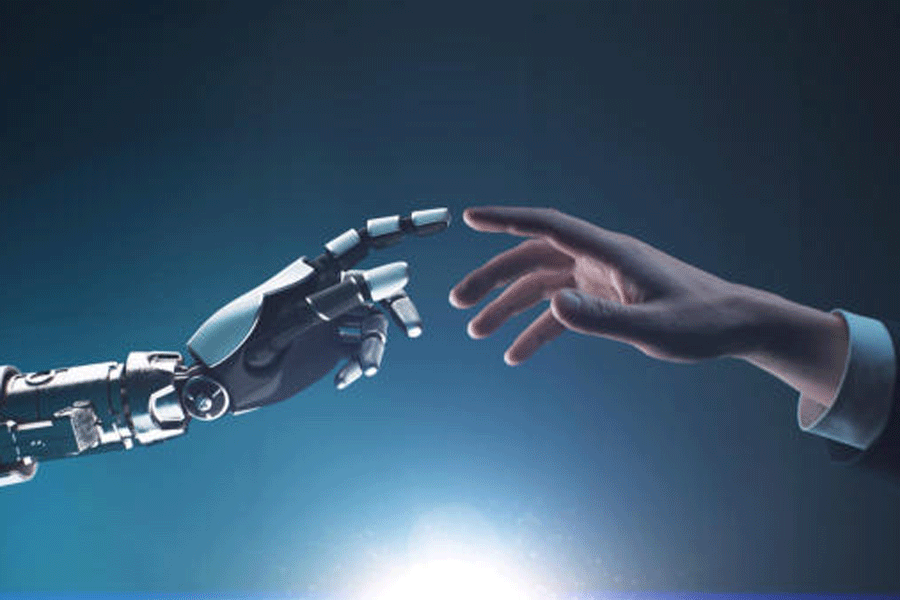What is AI?
Anything capable of mimicking human behaviour. Even a simple walking doll is also an AI machine.
Human civilization’s tryst with the idea of AI goes back to centuries before Christ. We’ve yearned for obedient power beyond ourselves, transcending the limitations of spouses, pets, and weapons.
Greek mythology introduced Talos, a colossal bronze creation of Hephaestus, commissioned by Zeus to safeguard Crete. In the 11th century, the Buddhist text Lokapannati tells of King Ajatashatru using robots, bhuta vahana yantra, to protect Buddha’srelics hidden beneath a stupa. The warrior robots were later disarmed by Emperor Ashoka. Ismail-al-Jazari, a 12th-century Arab luminary, is arguably hailed as the father of robotics; for his hydro-powered automata, including a humanoid waitress.
Leonardo da Vinci’s 15th-century sketches reveal a mechanical knight capable of movement. These early inklings evolved through the 20th century, culminating in industrial robots that mimicked human tasks, reducing manual labour in manufacturing.
Is AI only about robots?
In the 1950s, Alan Turing, renowned for decoding Enigma, posed a fundamental question: Can machines think? This query gave birth to Machine Learning (ML), a subset of AI algorithms (a process or set of rules to be followed in calculations or other problem-solving operations, especially by a computer) capable of “thinking” and making decisions. From automated telemarketing calls to IBM Watson surpassing champions in Jeopardy, the last three decades have witnessed remarkable strides in ML replicating human behaviour. In the 1980s, ML remained a realm of Hollywood fantasies like Robocop and Blade Runner. Today, it’s a tangible reality, even though we’re yet to see robots thinking like humans or plotting world domination.
Can ML transform lives?
AI’s impact on healthcare is profound. It enhances medical decision-making, reducing resource strain, enabling more doctor-patient interaction, and tailoring treatments. AI automates image-based medical reports, pre-emptively diagnoses cardiovascular issues, fractures, neurological conditions, tumours, and cancers. It streamlines EHR analysis, expediting critical parameter assessments, from real-time risk scores to predictive insights and improved decision-making like transfer to intensive care, discharge diagnosis, length of hospital stay etc. While AI still strives to match a doctor’s intuition, 2022 witnessed a pivotal moment with the advent of ChatGPT, poised to reshape AI akin to Netscape’s transformation of the internet in the ‘90s.
Does AI touch daily lives?
When you make digital payments using platforms like Paytm, Google Pay, or PhonePe, have you ever wondered who’s the Holmes keeping an eye out for fraudulent transactions? The next time you book an Ola or Uber, consider this: Who is the matchmaker between you and your driver? How does it calculate the fare so accurately, even during heavy traffic? When you shop online on Flipkart or Amazon, is there an “angrezo ke zamane ke tailor” who makes product recommendations that perfectly fit you? When you are driving in Bengaluru or Trivandrum, who do you think is keeping an eye on helmetless riders, passengers disregarding seat belts, reckless driving and illegal parking? As you navigate your daily life in India, remember that AI is often working behind the scenes, making things more convenient, secure, and efficient. Over time there would be more AI-powered mysteries that you would uncover in your daily routines.
What about ChatGPT?
ChatGPT represents a set of AI models called Generative AI, which is a further subset of ML. So, what is the difference between traditional AI and generative AI? Traditional AI is like a skilled chef who follows a strict recipe to bake one specific cake. It’s precise but not very creative. Generative AI, on the other hand, is like a playful magician in a bakery, conjuring up all sorts of cakes, from rainbow-sparkle unicorn cakes to gravity-defying floating cakes. While the chef sticks to a set menu, the magician loves surprising you with new creations. Think of traditional AI as a librarian who organizes books by genre and author, always the same. Generative AI is like a storyteller, inventing fresh tales with every page turn, keeping you entertained with its imaginative twists. You have an idea of a painting, but you do not even know how to hold the brush properly - simply go to DALL-E, type your idea and see how it generates a painting for you in seconds. You want a soundtrack for your short film, but you are far from being a composer — simply go to Beatoven.ai, answer a few questions and Voila! It has generated a piece of unique music for you. The public release of ChatGPT by OpenAI in November last year led to a massive surge of interest and hype around Artificial Intelligence, which since then has only continued to increase. While there have been technology innovations over the years, very few have captured the imagination of the public like ChatGPT, which has become a commonly discussed topic even among people who are not from the IT industry. You can love it, you can hate it, you cannot ignore it.
(Souvik Das is an IT professional providing Generative AI Solutions to clients across the world. Sampreeti Das is a student of computer science specialising in Generative AI)
In the long run will Artificial Intelligence be helpful or harmful?
Write to The Telegraph Salt Lake, 6 Prafulla Sarkar Street, Calcutta 700001 or email to saltlake@abp.in
